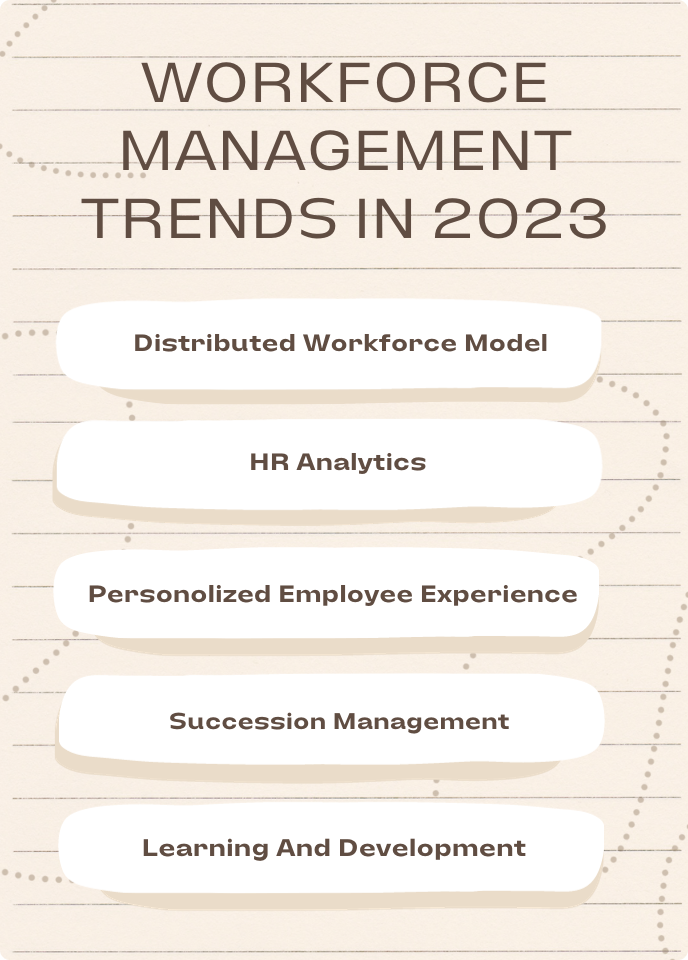
7 Tips to Manage Your Workforce
Ahh!! Your workforce! the engine that powers your company toward its goals. Your workforce isn’t just a collection of employees; it’s the lifeblood that courses through the veins of your organization, driving it forward with vigor and purpose.
These words show the vital role of workforce management in today’s dynamic business landscape. And effectively managing this workforce is a bit challenging. As an employer, you need to be constantly looking for ways to optimize your team’s performance and to improve workforce management. Fortunately, a treasure trove of straightforward yet incredibly potent methods awaits your discovery.
In this blog post, we are delving into those game changing strategies to manage your workforce. So keep reading. 🙂
What Is Workforce Management?

Workforce management has been making waves for some time now. But, what exactly is workforce management?
Workforce management (WFM) is a comprehensive set of processes and practices that organizations use to optimize the productivity, efficiency, and performance of their workforce. It involves planning, scheduling, tracking, and managing employees’ activities to ensure that the right people with the right skills are in the right place at the right time to meet business objectives and customer demands.
Having the right workforce management can be a difficult task when it comes to implementation. But it can be the most rewarding thing a company can do to keep the employees happy and compete in this era of technology by taking your employees along.
7 Ways to Manage Your Workforce
1. Assess What Matters to Your Employees

Assessing what matters to employees is a crucial aspect of effective workforce management within any organization. By understanding and addressing the needs, desires, and concerns of your workforce, you can foster a more engaged, and productive team.
To know what employees prefer, actively seek their input and feedback by conducting surveys and one-on-one conversations. This provides valuable insights into their preferences and concerns. Thereby, helping management to make necessary policies, benefits, and work arrangements that resonate with the workforce.
Most of the employees may need;
 A Flexible Work Schedule
A Flexible Work Schedule
 Work life balance
Work life balance
 Being valued and appreciated
Being valued and appreciated
 A career growth
A career growth
Moreover, when employees see that their opinions are valued and considered, they are more likely to feel appreciated and engaged. This can lead to higher job satisfaction and lower turnover rates.
2. Prioritize Employee Well-being

Prioritizing employee well-being means fostering an environment where employees feel valued, supported, and healthy, which, in turn, yields numerous benefits for both employees and the organization as a whole.
First and foremost, when organizations prioritize employee well-being, they create a more engaged and motivated workforce. Employees who feel their physical and mental health is a priority are more likely to be committed to their roles, resulting in increased productivity and better performance. Furthermore, an emphasis on well-being can have a positive impact on workplace culture. When employees see that their health and happiness matter to the organization, they are more likely to collaborate, communicate, and support each other, fostering a more cohesive and positive work environment.
As many workplaces can be sources of stress, offering resources like employee assistance programs, stress management workshops, or flexible work arrangements, organizations can help employees better cope with the demands of their jobs. This, in turn, reduces absenteeism, burnout, and the costs associated with employee mental health issues.
Lastly, prioritizing employee well-being aligns with corporate social responsibility and ethical business practices. Organizations that invest in the health and happiness of their employees contribute positively to society and demonstrate a commitment to ethical leadership.
3. Implement Workforce management software

To effectively manage a flexible workforce, organizations can leverage workforce management software. Here’s how this technology aids in workforce management:

Attendance Management
Efficiently tracks employee work hours, breaks, and overtime, simplifying attendance management tasks and ensuring accurate payroll processing.

Scheduling and Shift Management
This feature helps organizations create optimized employee schedules that meet operational demands, manage shift swaps, and stay compliant with labor laws and agreements.

Workforce Analytics and Performance Metrics
By analyzing workforce data, businesses can make informed decisions, improving overall workforce productivity and efficiency.

Leave and Absence Management
Simplifying leave tracking and management, this feature ensures accurate monitoring of employee absence, sick days, and leave balances.
4. Implement Flexible work arrangements

Implementing flexible work arrangements is a strategic approach to workforce management that can significantly benefit organizations by addressing the diverse needs and preferences of employees. Flexible work arrangements encompass various options, such as remote work, flexible hours, compressed workweeks, and job sharing. You can develop a more productive and content workforce by giving employees flexibility in their work schedules, locations, and working methods.
Here’s how these arrangements contribute to better workforce management:

Improved Work-Life Balance
Offering flexible work options allows employees to better balance their personal and professional lives. This can reduce stress and burnout, leading to increased job satisfaction and lower turnover rates.

Increased Productivity
Flexible work arrangements can boost productivity. Employees may find that they are more productive during hours that suit their individual rhythms, whether that’s early in the morning or later in the evening.

Attracting Diverse Talent
Organizations that provide flexibility in work arrangements appeal to a broader range of talent. This diversity can bring different perspectives and ideas, fostering innovation and creativity.

Business Continuity
In times of unexpected disruptions, like a pandemic, having a flexible workforce can ensure business continuity. Employees can seamlessly transition to remote work, minimizing disruptions to operations.
5. Measure Employee Productivity

Measuring employee productivity is another way for managing the workforce. It plays a multifaceted role in enhancing the efficiency, morale, and overall performance of the workforce. By evaluating and quantifying the output of individual employees and teams, organizations can make informed decisions that lead to improved productivity and, ultimately, better achievement of organizational goals.
One of the primary benefits of measuring employee productivity is its role in performance evaluation. Regular assessments based on objective productivity metrics allow managers to gain a clear understanding of how well employees are performing.
Resource allocation is another area where productivity measurement proves invaluable. By analyzing productivity data, organizations can pinpoint areas where productivity may be lacking. With this knowledge, they can allocate additional resources, adjust processes, or provide extra support to bolster performance in those areas.
Setting clear performance goals and motivating employees is an essential aspect of workforce management. By utilizing productivity metrics as performance benchmarks, organizations provide employees with well-defined objectives to strive for. These measurable targets enhance motivation and focus, as employees can track their progress and receive regular feedback.
6. Foster Continuous Learning and Development

Continuous learning and development create a culture of adaptability and innovation. In today’s rapidly changing business landscape, organizations that prioritize learning stay ahead. Employees who regularly acquire new skills and knowledge become more adaptable, enabling the organization to respond swiftly to industry trends, technological advancements, and evolving customer needs.
Employees who receive regular training and opportunities for skill improvement tend to be more competent and confident in their roles. This not only boosts individual productivity but also contributes to overall workforce efficiency. Moreover, continuous learning and development facilitate succession planning and talent management. By identifying high-potential employees and providing them with opportunities for growth, organizations can build a pipeline of future leaders.
It’s also worth noting that a learning-oriented culture fosters employee satisfaction and well-being. Employees who feel supported in their growth are more likely to experience job satisfaction and reduced stress. This positively impacts workforce management by contributing to a healthier and more engaged workforce, which, in turn, leads to increased productivity and collaboration.
7. Adapt to Changing Workforce Management Trends

Workforce management trends evolve with the ever-changing business landscape. Hence, it is important to stay updated inorder to stay ahead of the curve. Here’s how it helps:
 By staying updated, organizations can remain competitive in their respective industries. Implementing new strategies and technologies can give them an edge over competitors.
By staying updated, organizations can remain competitive in their respective industries. Implementing new strategies and technologies can give them an edge over competitors.
 Embracing new trends often involves adopting innovative tools and practices that can streamline work processes. This leads to increased productivity among employees, allowing them to achieve more with less effort.
Embracing new trends often involves adopting innovative tools and practices that can streamline work processes. This leads to increased productivity among employees, allowing them to achieve more with less effort.
Many workforce trends focus on employee satisfaction and well-being. Companies that adapt to these trends tend to attract top talent and retain their existing workforce.
 Employees are more likely to stay with organizations that prioritize their needs and professional development.
Employees are more likely to stay with organizations that prioritize their needs and professional development.
 Many modern trends in workforce management leverage data analytics to make informed decisions. Adapting to these trends enables organizations to gather and analyze data more effectively, leading to better decision-making in areas like recruitment, performance assessment, and talent development.
Many modern trends in workforce management leverage data analytics to make informed decisions. Adapting to these trends enables organizations to gather and analyze data more effectively, leading to better decision-making in areas like recruitment, performance assessment, and talent development.
 Workforce management trends often address evolving labor laws and regulations. Adapting to these changes ensures that the organization remains compliant, reducing the risk of legal issues and penalties.
Workforce management trends often address evolving labor laws and regulations. Adapting to these changes ensures that the organization remains compliant, reducing the risk of legal issues and penalties.
 Trends like employee wellness and work-life balance contribute to higher employee engagement and morale. Engaged employees are more productive and committed to their roles, which ultimately benefits the organization.
Trends like employee wellness and work-life balance contribute to higher employee engagement and morale. Engaged employees are more productive and committed to their roles, which ultimately benefits the organization.
 By staying ahead on these trends, organizations can prepare for future challenges and opportunities. This proactive approach ensures that the workforce remains adaptable and resilient in the face of uncertainty.
By staying ahead on these trends, organizations can prepare for future challenges and opportunities. This proactive approach ensures that the workforce remains adaptable and resilient in the face of uncertainty.

In A Nutshell
That’s all folks. It’s time to wrap up. We’ve explored seven dynamic ways to manage your workforce that can elevate your organization to new heights. But remember, workforce management is not a one-size-fits-all solution. It’s an ongoing process that requires adaptability and continuous improvement.
So, the key takeaway here is: your workforce is your greatest asset, and with the right strategies, you can unlock their true potential. Now, it’s your turn to take action. Reflect on the tips we’ve discussed and start implementing them in your organization today. Good Luck!
Comments